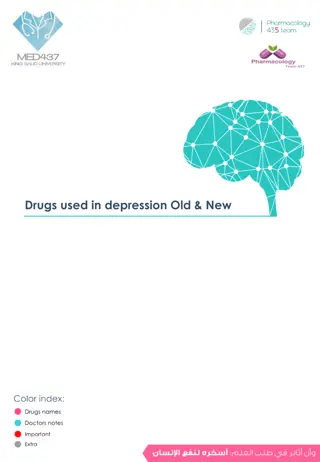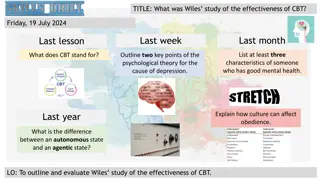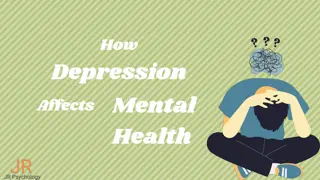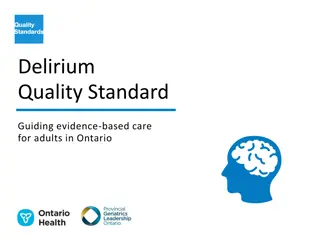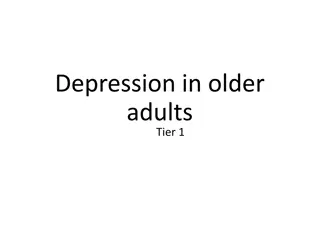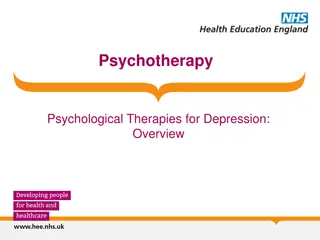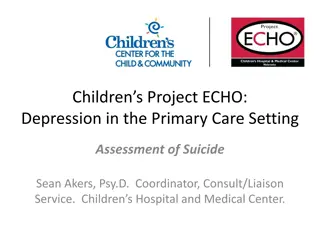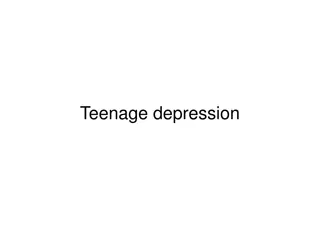Importance of Quality Standards in Major Depression Care
Understanding the need for quality standards in major depression care for adults and adolescents in Ontario. This brief highlights the significance of creating quality standards, providing data demonstrating the necessity for improvement in care, and emphasizing the role of these standards in enhancing the quality of healthcare delivery for individuals with major depression.
Download Presentation

Please find below an Image/Link to download the presentation.
The content on the website is provided AS IS for your information and personal use only. It may not be sold, licensed, or shared on other websites without obtaining consent from the author. Download presentation by click this link. If you encounter any issues during the download, it is possible that the publisher has removed the file from their server.
E N D
Presentation Transcript
INFORMATION AND DATA BRIEF: Why this quality standard is needed Major Depression Care for Adults and Adolescents Let s make our health system healthier
What Are Quality Standards Concise sets of easy-to-understand statements outlining what care should look like for people living with certain conditions and being cared for in specific settings Based on the best available evidence Designed for health care providers to know what care they should be offering To also help patients, residents, families and caregivers know what to ask for in their care www.HQOntario.ca 1
The Purpose of this Brief In Ontario, major depression is the most common mental illness [1] In a given year, nearly 5% of adults in Ontario experience major depression [1] This brief provides information and data demonstrating why a quality standard is needed for people with major depression Specifically, it provides performance data on indicators that reflect the care received by people experiencing major depression [1] Statistics Canada Table, 105-1101 Mental Health Profile, Canadian Community Health Survey Mental Health (CCHS) 2012 www.HQOntario.ca 2
The Purpose of this Brief The data demonstrate that care for people experiencing major depression needs to be improved That is why the quality standard has been created: To inform clinicians and organizations what high-quality health care for people living with this condition should look like To help clinicians and organizations assess the quality of care they are delivering, so they can identify gaps and areas for improvement www.HQOntario.ca 3
How We Look at the Data When available, the information presented reflects different perspectives Provincial results over time offer a broad overall system view Results by LHIN region highlight some of the local differences The distribution of the results across facilities provides some points of reference to hospitals www.HQOntario.ca 4
THE DATA www.HQOntario.ca
Some Context Because the quality standard aims at improving health outcomes among people living with major depression, early in its development, a set of indicators had been selected to measure the impact of the major depression quality standard as a whole. We examine the following as overall measures of performance: Percentage of emergency department visits for major depression that are a person s first contact with health care services for a diagnosis of major depression Percentage of patients who were readmitted to hospital for a mental health or addictions condition within 30 days of a previous hospital discharge for major depression Percentage of patients who revisited the emergency department for a mental health or addictions condition within 30 days of a previous emergency department visit for major depression www.HQOntario.ca 6
Of patients who visited the emergency department for major depression in 2014, 20.5% had not accessed mental health or addictions services from a physician in the previous two years. This proportion has not improved over the last eight years. Percentage of patients who had visited the emergency department for major depression, and had not accessed mental health or addictions services from a physician in the previous two years, in Ontario, 2006 to 2014 www.HQOntario.ca 7
Of patients who visited the emergency department for major depression from 2012 to 2014, the proportion of those who had not accessed mental health or addictions services from a physician in the previous two years varied across LHIN regions, ranging from 16.7% to 30.9%. Percentage of patients who had visited the emergency department for major depression, and had not accessed mental health or addictions services from a physician in the previous two years, in Ontario, by LHIN region, three-year average for 2012 to 2014 www.HQOntario.ca 8
10.1% of patients were readmitted to hospital for a mental health or addictions condition within 30 days of a previous hospital discharge for major depression, and this proportion had not changed in the last eight years. Percentage of patients who were readmitted to hospital for a mental health or addictions condition within 30 days of a previous hospital discharge for major depression, in Ontario, 2006 to 2014 www.HQOntario.ca 9
The percentage of patients who were readmitted to hospital for a mental health or addictions condition within 30 days of a previous hospital discharge for major depression varied across LHIN regions from 7.9% to 12.4%. Percentage of patients who were readmitted to hospital for a mental health or addictions condition within 30 days of a previous hospital discharge for major depression, in Ontario by LHIN region, three-year average for 2012 to 2014 www.HQOntario.ca 10
Across facilities in Ontario, the percentage of patients who were readmitted to hospital for a mental health or addictions condition within 30 days of a previous hospital discharge for major depression varied from 3.5% to 21.5%. Percentage of patients who were readmitted to hospital for a mental health or addictions condition within 30 days of a previous hospital discharge for major depression, in Ontario, by facility, three-year average for 2012 to 2014 www.HQOntario.ca 11
10% of patients revisited the emergency department for a mental health or addictions condition within 30 days of a previous emergency department visit for major depression. This proportion has remained stable over the last eight years. Percentage of patients who had visited the emergency department for major depression, and had not accessed mental health or addictions services from a physician in the previous two years, in Ontario, 2006 to 2014 www.HQOntario.ca 12
The percentage of patients who revisited the emergency department for a mental health or addictions condition within 30 days of a previous emergency department visit for major depression varied by LHIN region from 8.8% to 12.3%. Percentage of patients who revisited the emergency department for a mental health or addictions condition within 30 days of a previous emergency department visit for major depression, in Ontario by LHIN region, three- year average for 2012 to 2014 www.HQOntario.ca 13
Across facilities in Ontario, the percentage of patients who revisited the emergency department for a mental health or addictions condition within 30 days of a previous emergency department visit for major depression varied from 0% to 18.3%. Percentage of patients who revisited the emergency department for a mental health or addictions condition within 30 days of a previous emergency department visit for major depression, in Ontario, by facility, three-year average for 2012 to 2014 www.HQOntario.ca 14
Some Context The quality standard recommends that if you move on to a new health care professional, you should receive a written copy of your care plan from your previous health care professional and your first appointment should be scheduled within a specific timeline. So we examined the percentage of patients who had contact with a family doctor or a psychiatrist within seven days of a previous hospital discharge for major depression. ww.HQOntario.ca 15
37.3% of patients had a contact with a family doctor or psychiatrist within seven days of a hospital discharge for major depression, and this proportion has not changed over the past eight years. Percentage of patients who had contact with a family doctor or a psychiatrist within seven days of a hospital discharge for major depression, in Ontario, 2006 to 2014 www.HQOntario.ca 16
The percentage of patients who had contact with a family doctor or a psychiatrist within seven days of a hospital discharge for major depression varies across LHIN regions, raging from 25.1% to 48.1%. Percentage of patients who had contact with a family doctor or a psychiatrist within seven days of a previous hospital discharge for major depression, in Ontario, by LHIN region, three-year average for 2012 to 2014 www.HQOntario.ca 17
Across facilities in Ontario, the percentage of patients who had contact with a family doctor or a psychiatrist within seven days of a previous hospital discharge for major depression varied from 11.5% to 60.1%. Percentage of patients who had contact with a family doctor or a psychiatrist within seven days of a previous hospital discharge for major depression, in Ontario, by facility, three-year average for 2012 to 2014 www.HQOntario.ca 18
Additional Resources This Information Brief is intended to support the Major Depression Quality Standard, which can be found in full HERE www.HQOntario.ca 19
Acknowledgements Health Quality Ontario thanks Paul Kurdyak (Institute for Clinical and Evaluative Sciences (ICES) and Centre for Addiction and Mental Health (CAMH)) for his contributions to this publication. Health Quality Ontario would also like to thank Abigail Amartey, Jenny Gatov, Julie Yang and Maria Chiu of the MHASEF (Mental Health and Addictions Scorecard and Evaluation Framework) Research Team. The MHASEF Research Team is supported by a grant from the Ontario Ministry of Health and Long-Term Care. www.HQOntario.ca 20
Acknowledgements Notes: Some of the indicators in this report were derived using health administrative datasets from Ontario. These datasets were linked using unique encoded identifiers and analyzed at ICES. www.HQOntario.ca 21
www.HQOntario.ca FOLLOW@HQOntario








